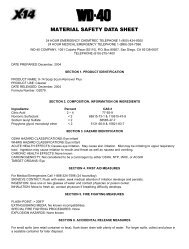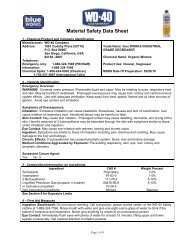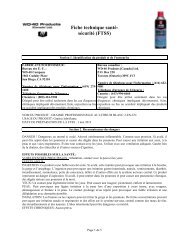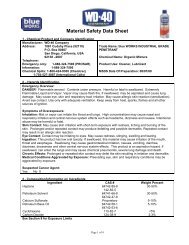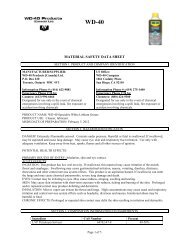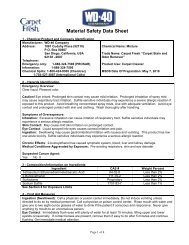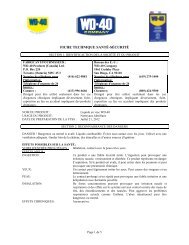ChemWatch MSDS 4944-63 - WD-40 Company
ChemWatch MSDS 4944-63 - WD-40 Company
ChemWatch MSDS 4944-63 - WD-40 Company
You also want an ePaper? Increase the reach of your titles
YUMPU automatically turns print PDFs into web optimized ePapers that Google loves.
<strong>WD</strong>-<strong>40</strong> 3-IN-ONE PENETRANT SPRAY<br />
<strong>ChemWatch</strong> Material Safety Data Sheet CHEMWATCH <strong>4944</strong>-<strong>63</strong><br />
Issue Date: Thu 17-Apr-2003 CD 2003/1 Page 1 of 10<br />
IDENTIFICATION<br />
STATEMENT OF HAZARDOUS NATURE<br />
SUPPLIER<br />
HAZARDOUS ACCORDING TO WORKSAFE AUSTRALIA CRITERIA.<br />
<strong>Company</strong>: <strong>WD</strong>-<strong>40</strong> <strong>Company</strong>(Australia P/L)<br />
Address:<br />
41 Rawson Street<br />
Epping<br />
NSW2121<br />
Australia<br />
Telephone: +61 2 9868 2200<br />
Fax: +61 2 9869 7512<br />
Product Name:<br />
<strong>WD</strong>-<strong>40</strong> 3-in-One Penetrant Spray<br />
CAS RN No(s):<br />
None<br />
UN Number: 1950<br />
Packing Group:<br />
None<br />
Dangerous Goods Class: 2.1<br />
SubsidiaryRisk:<br />
None<br />
Hazchem Code:<br />
2Y<br />
Poisons Schedule Number: None<br />
USE<br />
Lubricant spray.<br />
Application is by spray atomisation from a hand held aerosol pack<br />
PHYSICAL DESCRIPTION/PROPERTIES<br />
APPEARANCE<br />
Light amber liquid with a petroleum odour; does not mix with water.<br />
Supplied as an aerosol pack. Contents under PRESSURE. Contains highly flammable<br />
hydrocarbon propellant.<br />
Boiling Point (°C):<br />
Not available<br />
Melting Point (°C):<br />
Not available<br />
Vapour Pressure (kPa): Not available<br />
SpecificGravity: 0.80<br />
Flash Point (°C): -28.89<br />
Lower Explosive Limit (%): 1.8<br />
Upper Explosive Limit (%): 9.5<br />
continued...
<strong>WD</strong>-<strong>40</strong> 3-IN-ONE PENETRANT SPRAY<br />
<strong>ChemWatch</strong> Material Safety Data Sheet CHEMWATCH <strong>4944</strong>-<strong>63</strong><br />
Issue Date: Thu 17-Apr-2003 CD 2003/1 Page 2 of 10<br />
IDENTIFICATION ...<br />
Solubilityin Water (g/L):<br />
Immiscible<br />
INGREDIENTS<br />
NAME CAS RN %<br />
solvent naphtha petroleum, medium aliphatic 64742-88-7 30-<strong>40</strong><br />
isoparaffins petroleum hydrotreated HFP 64742-47-8. 30-<strong>40</strong><br />
paraffinic distillate, light, solvent-dewaxed (sev 64742-56-9. 3-6<br />
fragrance
<strong>WD</strong>-<strong>40</strong> 3-IN-ONE PENETRANT SPRAY<br />
<strong>ChemWatch</strong> Material Safety Data Sheet CHEMWATCH <strong>4944</strong>-<strong>63</strong><br />
Issue Date: Thu 17-Apr-2003 CD 2003/1 Page 3 of 10<br />
HEALTH HAZARD ...<br />
coughing and nausea, central nervous depression with headache and dizziness,<br />
slowing of reflexes, fatigue and inco-ordination.<br />
If exposure to highly concentrated solvent atmosphere is prolonged this may<br />
lead to narcosis, unconsciousness, even coma and possible death.<br />
WARNING:Intentional misuse by concentrating/inhaling contents may be lethal.<br />
CHRONIC HEALTH EFFECTS<br />
FIRST AID<br />
Principal routes of exposure are usually by skin contact and inhalation of<br />
vapour/spray mist<br />
Chronic solvent inhalation exposures may result in nervous system impairment<br />
and liver and blood changes. [PATTYS]<br />
Prolonged or continuous skin contact with the liquid may cause defatting with<br />
drying, cracking, irritation and dermatitis following.<br />
WARNING: Aerosol containers may present pressure related hazards.<br />
SWALLOWED<br />
If swallowed do NOT induce vomiting.<br />
If vomiting occurs, lean patient forward or place on left side (head-down<br />
position, if possible) to maintain open airway and prevent aspiration.<br />
Observe the patient carefully.<br />
Never give liquid to a person showing signs of being sleepy or with reduced<br />
awareness; i.e. becoming unconscious.<br />
Give water to rinse out mouth, then provide liquid slowly and as much as<br />
casualty can comfortably drink.<br />
Seek medical advice.<br />
EYE<br />
If this product comes in contact with the eyes:<br />
Immediately hold eyelids apart and flush the eye continuously with running<br />
water.<br />
Ensure complete irrigation of the eye by keeping eyelids apart and away from<br />
eye and moving the eyelids by occasionally lifting the upper and lower lids.<br />
Continue flushing until advised to stop by the Poisons Information Centre or a<br />
doctor, or for at least 15 minutes.<br />
Transport to hospital or doctor without delay.<br />
Removal of contact lenses after an eye injury should only be undertaken by<br />
skilled personnel.<br />
SKIN<br />
If solids or aerosol mists are deposited upon the skin:<br />
Flush skin and hair with running water (and soap if available).<br />
Remove any adhering solids with industrial skin cleansing cream.<br />
DO NOT use solvents.<br />
Seek medical attention in the event of irritation.<br />
continued...
<strong>WD</strong>-<strong>40</strong> 3-IN-ONE PENETRANT SPRAY<br />
<strong>ChemWatch</strong> Material Safety Data Sheet CHEMWATCH <strong>4944</strong>-<strong>63</strong><br />
Issue Date: Thu 17-Apr-2003 CD 2003/1 Page 4 of 10<br />
HEALTH HAZARD ...<br />
INHALED<br />
If fumes or combustion products are inhaled remove from contaminated area.<br />
Lay patient down. Keep warm and rested.<br />
Prostheses such as false teeth, which may block airway, should be removed,<br />
where possible, prior to initiating first aid procedures.<br />
Apply artificial respiration if not breathing, preferably with a demand valve<br />
resuscitator, bag-valve mask device, or pocket mask as trained. Perform CPR if<br />
necessary.<br />
Transport to hospital, or doctor.<br />
ADVICE TO DOCTOR<br />
For acute or short term repeated exposures to petroleum distillates or related<br />
hydrocarbons:<br />
Primarythreat to life, from pure petroleum distillate ingestion and/or<br />
inhalation, is respiratoryfailure.<br />
Patients should be quicklyevaluated for signs of respiratorydistress (e.g.<br />
cyanosis,tachypnoea, intercostal retraction, obtundation) and given oxygen.<br />
Patients with inadequate tidal volumes or poor arterial blood gases (pO2 50 mm<br />
Hg) should be intubated.<br />
Arrhythmias complicate some hydrocarbon ingestion and/or inhalation and<br />
electrocardiographicevidence of myocardial injuryhas been reported;<br />
intravenous lines and cardiac monitors should be established in obviously<br />
symptomaticpatients.The lungs excrete inhaled solvents,so that<br />
hyperventilation improves clearance<br />
Achest x-rayshould be taken immediatelyafter stabilisation of breathing and<br />
circulation to document aspiration and detect the presence of pneumothorax.<br />
Epinephrine (adrenalin) is not recommended for treatment of bronchospasm<br />
because of potential myocardial sensitisation to catecholamines.Inhaled<br />
cardioselective bronchodilators (e.g. Alupent, Salbutamol) are the preferred<br />
agents,with aminophylline a second choice.<br />
Lavage is indicated in patients who require decontamination; ensure use of<br />
cuffed endotracheal tube in adult patients.[Ellenhorn and Barceloux: Medical<br />
Toxicology]<br />
PRECAUTIONS FOR USE<br />
EXPOSURE STANDARDS<br />
None assigned. Refer to individual constituents.<br />
INGREDIENT DATA<br />
SOLVENTNAPHTHAPETROLEUM, MEDIUMALIPHATIC:<br />
TLVTWA: 300 ppm A3 [ACGIH]<br />
CEL TWA: 100 ppm, 525 mg/m³<br />
as VM & P Naphtha (petroleum ether) (CAS RN: 8032-32-4)<br />
TLVTWA: 300 ppm, A3<br />
[Manufacturer]<br />
continued...
<strong>WD</strong>-<strong>40</strong> 3-IN-ONE PENETRANT SPRAY<br />
<strong>ChemWatch</strong> Material Safety Data Sheet CHEMWATCH <strong>4944</strong>-<strong>63</strong><br />
Issue Date: Thu 17-Apr-2003 CD 2003/1 Page 5 of 10<br />
PRECAUTIONS FOR USE ...<br />
Naphthas of this type produce central nervous system depression and are mild<br />
irritants of the eyes and upper respiratorytract. The carcinogenicpotential<br />
of middle petroleum distillates is recognised and is related to the content of<br />
polynuclear aromatichydrocarbons<br />
(PAHs). The TLVis thought to be protective against the acute effects of upper<br />
respiratorytract and eye irritation and chronicsystemic effects.<br />
CAUTION: This substance has been classified bythe ACGIH as A3<br />
Animal carcinogen (at relativelyhigh doses)<br />
for petroleum distillates:<br />
CEL TWA: 500 ppm, 2000 mg/m³ (compare OSHATWA)<br />
ISOPARAFFINS PETROLEUMHYDROTREATED HFP:<br />
REL TWA: 300 ppm [EXXON]<br />
for petroleum distillates:<br />
CEL TWA: 500 ppm, 2000 mg/m³ (compare OSHATWA)<br />
PARAFFINIC DISTILLATE, LIGHT, SOLVENT-DEWAXED (SEV:<br />
PEL TWA: 5 mg/m³ [OSHAZ1]<br />
oil mist, mineral<br />
TLVTWA: 5 mg/m³; STEL: 10 mg/m³.<br />
NOTICE OF INTENDED CHANGE.<br />
TLVTWA 0.2 mg/m³ inhalable fraction highlyrefined A4<br />
NOTE: This substance has been classified bythe ACGIH as A4<br />
NOT classifiable as causing cancer in humans.<br />
ES TWA: 5 mg/m³ (oil mist, refined mineral)<br />
Human exposure to oil mist alone has not been demonstrated to cause health<br />
effects except at levels above 5 mg/m³ (this applies to particulates sampled by<br />
a method that does not collect vapour). It is not advisable to applythis<br />
standard to oils containing unknown concentrations and types of additive.<br />
HYDROCARBON PROPELLANT:<br />
hydrocarbon propellant, as liquified petroleum gas<br />
TLVTWA: 1000 ppm, 1800 mg/m³<br />
ES TWA: 1000 ppm, 1800 mg/m³<br />
OES TWA: 1000 ppm, 1750 mg/m³; STEL: 1250 ppm, 2180 mg/m³<br />
ENGINEERING CONTROLS<br />
General exhaustis adequate under normal operating conditions.If risk of<br />
overexposure exists,wear SAA approved respirator. Correct fit is essential to<br />
obtain adequate protection. Provide adequate ventilation in warehouseor closed<br />
storage areas. Air contaminants generated in the workplace possess varying<br />
"escape" velocities which, in turn, determine the "capture velocities"of fresh<br />
circulating air required to effectivelyremove the contaminant.<br />
Type of Contaminant:<br />
solvent, vapours,degreasing etc.,<br />
evaporating from tank (in still air)<br />
aerosols, fumes from pouring<br />
operations,intermittent container<br />
filling, low speed conveyer transfers,<br />
welding, spraydrift, plating acid<br />
Air Speed:<br />
0.25-0.5 m/s (50-100 f/min)<br />
0.5-1 m/s (100-200 f/min.)<br />
continued...
<strong>WD</strong>-<strong>40</strong> 3-IN-ONE PENETRANT SPRAY<br />
<strong>ChemWatch</strong> Material Safety Data Sheet CHEMWATCH <strong>4944</strong>-<strong>63</strong><br />
Issue Date: Thu 17-Apr-2003 CD 2003/1 Page 6 of 10<br />
PRECAUTIONS FOR USE ...<br />
fumes, pickling (released at low<br />
velocityinto zone of active<br />
generation)<br />
direct spray, spraypainting in<br />
shallow booths,drum filling, conveyer<br />
loading, crusher dusts, gas discharge<br />
(active generation into zone of rapid<br />
air motion)<br />
grinding, abrasive blasting, tumbling,<br />
high speed wheel generated dusts<br />
(released at high initial velocity<br />
into zone of veryhigh rapid air<br />
motion).<br />
1-2.5 m/s (200-500 f/min)<br />
2.5-10 m/s (500-2000 f/min.)<br />
Within each range the appropriate value depends on:<br />
Lower end of the range<br />
Upper end of the range<br />
1: Room air currents minimal or 1: Disturbing room air currents<br />
favourable to capture<br />
2: Contaminants of low toxicityor of 2: Contaminants of high toxicity<br />
nuisance value only<br />
3: Intermittent, low production. 3: High production, heavy use<br />
4: Large hood or large air mass in 4: Small hood - local control only<br />
motion<br />
PERSONAL PROTECTION<br />
Simple theoryshows that air velocityfalls rapidlywith distance awayfrom the<br />
opening of a simple extraction pipe. Velocitygenerallydecreases with the<br />
square of distance from the extraction point (in simple cases). Therefore the<br />
air speed at the extraction point should be adjusted, accordingly, after<br />
reference to distance from the contaminating source. The air velocityat the<br />
extraction fan, for example, should be a minimum of 1-2 m/s (200-<strong>40</strong>0 f/min.)<br />
for extraction of solvents generated in a tank 2 meters distant from the<br />
extraction point. Other mechanical considerations,producing performance<br />
deficits within the extraction apparatus,make it essential that theoretical<br />
air velocities are multiplied byfactors of 10 or more when extraction systems<br />
are installed or used.<br />
EYE<br />
Safetyglasses with side shields; or as required, Chemical goggles. Contact<br />
lenses pose a special hazard; soft lenses mayabsorb irritants and all lenses<br />
concentrate them.<br />
HANDS/FEET<br />
No special equipment needed when handling small quantities.<br />
OTHERWISE: Wear general protective gloves,eg. light weight rubber gloves.Or<br />
as required: Wear chemical protective gloves,eg. PVC. Wear safetyfootwear.<br />
continued...
<strong>WD</strong>-<strong>40</strong> 3-IN-ONE PENETRANT SPRAY<br />
<strong>ChemWatch</strong> Material Safety Data Sheet CHEMWATCH <strong>4944</strong>-<strong>63</strong><br />
Issue Date: Thu 17-Apr-2003 CD 2003/1 Page 7 of 10<br />
PRECAUTIONS FOR USE ...<br />
OTHER<br />
No special equipment needed when handling small quantities.<br />
OTHERWISE:<br />
Overalls.<br />
Skin cleansing cream.<br />
Eyewashunit.<br />
Do not sprayon hot surfaces.<br />
RESPIRATOR<br />
Respiratoryprotection maybe required when ANY"WorstCase" vapour-phase<br />
concentration is exceeded (see Computer Prediction in "Exposure Standards")<br />
Protection Factor (Min) Half-Face Respirator Full-Face Respirator<br />
10 xES Air-line* A-2<br />
- A-PAPR-2<br />
20 xES - A-3<br />
20+ xES - Air-line**<br />
* - Continuous-flow; ** - Continuous-flow or positive pressure demand<br />
^- Full-face<br />
The local concentration of material, quantityand conditions of use determine<br />
the type of personal protective equipment required. For further information<br />
consult site specific CHEMWATCH data (if available), or your Occupational<br />
Health and SafetyAdvisor.<br />
SAFE HANDLING<br />
STORAGE AND TRANSPORT<br />
SUITABLE CONTAINER<br />
Aerosol dispenser. Check that containers are clearly labelled.<br />
STORAGE INCOMPATIBILITY<br />
Avoid storage with oxidisers<br />
STORAGE REQUIREMENTS<br />
Store in original containers in approved flame-proof area.<br />
DO NOT store in pits, depressions, basements or areas where vapours may be<br />
trapped.<br />
No smoking, naked lights, heat or ignition sources.<br />
Keep containers securely sealed. Contents under pressure.<br />
Store away from incompatible materials.<br />
Store in a cool, dry, well ventilated area in an upright position.<br />
Avoid storage at temperatures higher than <strong>40</strong> deg C.<br />
Protect containers against physical damage and check regularly for leaks.<br />
Observe manufacturer's storing and handling recommendations.<br />
continued...
<strong>WD</strong>-<strong>40</strong> 3-IN-ONE PENETRANT SPRAY<br />
<strong>ChemWatch</strong> Material Safety Data Sheet CHEMWATCH <strong>4944</strong>-<strong>63</strong><br />
Issue Date: Thu 17-Apr-2003 CD 2003/1 Page 8 of 10<br />
SAFE HANDLING ...<br />
TRANSPORTATION<br />
Class 2.1 - Flammable gases shall not be loaded in the same vehicle or packed<br />
in the same freight container with:<br />
Class 1 - Explosives;<br />
Class 3 - Flammable liquids (where both flammable liquids and flammable gases<br />
are in bulk);<br />
Class 4.1 - Flammable solids;<br />
Class 4.2 - Spontaneously combustible substances;<br />
Class 4.3 - Dangerous when wet substances;<br />
Class 5.1 - Oxidising agents;<br />
Class 5.2 - Organic peroxides;<br />
Class 7 - Radioactive substances.<br />
SPILLS AND DISPOSAL<br />
MINOR SPILLS<br />
Clean up all spills immediately.<br />
Avoid breathing vapours and contact with skin and eyes.<br />
Wear protective clothing, impervious gloves and safety glasses.<br />
Shut off all possible sources of ignition and increase ventilation.<br />
Wipe up.<br />
If safe, damaged cans should be placed in a container outdoors, away from all<br />
ignition sources, until pressure has dissipated.<br />
Undamaged cans should be gathered and stowed safely.<br />
MAJOR SPILLS<br />
Clear area of personnel and move upwind.<br />
Alert Fire Brigade and tell them location and nature of hazard.<br />
May be violently or explosively reactive.<br />
Wear breathing apparatus plus protective gloves.<br />
Prevent, by any means available, spillage from entering drains or water courses<br />
No smoking, naked lights or ignition sources.<br />
Increase ventilation.<br />
Stop leak if safe to do so.<br />
Water spray or fog may be used to disperse / absorb vapour.<br />
Absorb or cover spill with sand, earth, inert materials or vermiculite.<br />
If safe, damaged cans should be placed in a container outdoors, away from<br />
ignition sources, until pressure has dissipated.<br />
Undamaged cans should be gathered and stowed safely.<br />
Collect residues and seal in labelled drums for disposal.<br />
DISPOSAL<br />
Consult State Land Waste Management Authority for disposal.<br />
Discharge contents of damaged aerosol cans at an approved site.<br />
Allow small quantities to evaporate.<br />
DO NOT incinerate or puncture aerosol cans.<br />
Bury residues and emptied aerosol cans at an approved site.<br />
continued...
<strong>WD</strong>-<strong>40</strong> 3-IN-ONE PENETRANT SPRAY<br />
<strong>ChemWatch</strong> Material Safety Data Sheet CHEMWATCH <strong>4944</strong>-<strong>63</strong><br />
Issue Date: Thu 17-Apr-2003 CD 2003/1 Page 9 of 10<br />
SAFE HANDLING ...<br />
FIRE FIGHTERS' REPORT<br />
EXTINGUISHING MEDIA<br />
Water spray or fog.<br />
Foam.<br />
Dry chemical powder.<br />
BCF (where regulations permit).<br />
Carbon dioxide.<br />
FIRE FIGHTING<br />
Alert Fire Brigade and tell them location and nature of hazard.<br />
May be violently or explosively reactive.<br />
Wear breathing apparatus plus protective gloves.<br />
Prevent, by any means available, spillage from entering drains or water course.<br />
If safe, switch off electrical equipment until vapour fire hazard removed.<br />
Use water delivered as a fine spray to control fire and cool adjacent area.<br />
DO NOT approach containers suspected to be hot.<br />
Cool fire exposed containers with water spray from a protected location.<br />
If safe to do so, remove containers from path of fire.<br />
Equipment should be thoroughly decontaminated after use.<br />
When any large container (including road and rail tankers) is involved in a fire,<br />
consider evacuation by 100 metres in all directions.<br />
FIRE/EXPLOSION HAZARD<br />
Liquid and vapour are highly flammable.<br />
Severe fire hazard when exposed to heat or flame.<br />
Vapour forms an explosive mixture with air.<br />
Severe explosion hazard, in the form of vapour, when exposed to flame or spark.<br />
Vapour may travel a considerable distance to source of ignition.<br />
Heating may cause expansion or decomposition with violent container rupture.<br />
Aerosol cans may explode on exposure to naked flames.<br />
Rupturing containers may rocket and scatter burning materials.<br />
Hazards may not be restricted to pressure effects.<br />
May emit acrid, poisonous or corrosive fumes.<br />
On combustion, may emit toxic fumes of carbon monoxide (CO).<br />
Other combustion products include carbon dioxide (CO2)<br />
FIRE INCOMPATIBILITY<br />
Avoid contamination with strong oxidising agents as ignition may result<br />
HAZCHEM<br />
2Y<br />
continued...
<strong>WD</strong>-<strong>40</strong> 3-IN-ONE PENETRANT SPRAY<br />
<strong>ChemWatch</strong> Material Safety Data Sheet CHEMWATCH <strong>4944</strong>-<strong>63</strong><br />
Issue Date: Thu 17-Apr-2003 CD 2003/1 Page 10 of 10<br />
CONTACT POINT<br />
End of Report<br />
COMPANYCONTACT<br />
+61 2 9868 2200<br />
AUSTRALIAN POISONS INFORMATION CENTRE<br />
24 HOUR SERVICE: 13 11 26<br />
POLICE, FIRE BRIGADE OR AMBULANCE: 000<br />
NEWZEALAND POISONS INFORMATION CENTRE<br />
24 HOUR SERVICE: (03) 4747 000<br />
NZEMERGENCYSERVICES: 111<br />
Issue Date: Thu 17-Apr-2003<br />
Print Date: Wed 23-Apr-2003<br />
This document is copyright. Apart from any fair dealing for the purposes of<br />
private study, research, review or criticism, as permitted under the Copyright<br />
Act, no part may be reproduced by any process without written permission from<br />
CHEMWATCH. TEL (+61 3) 9572 4700.



